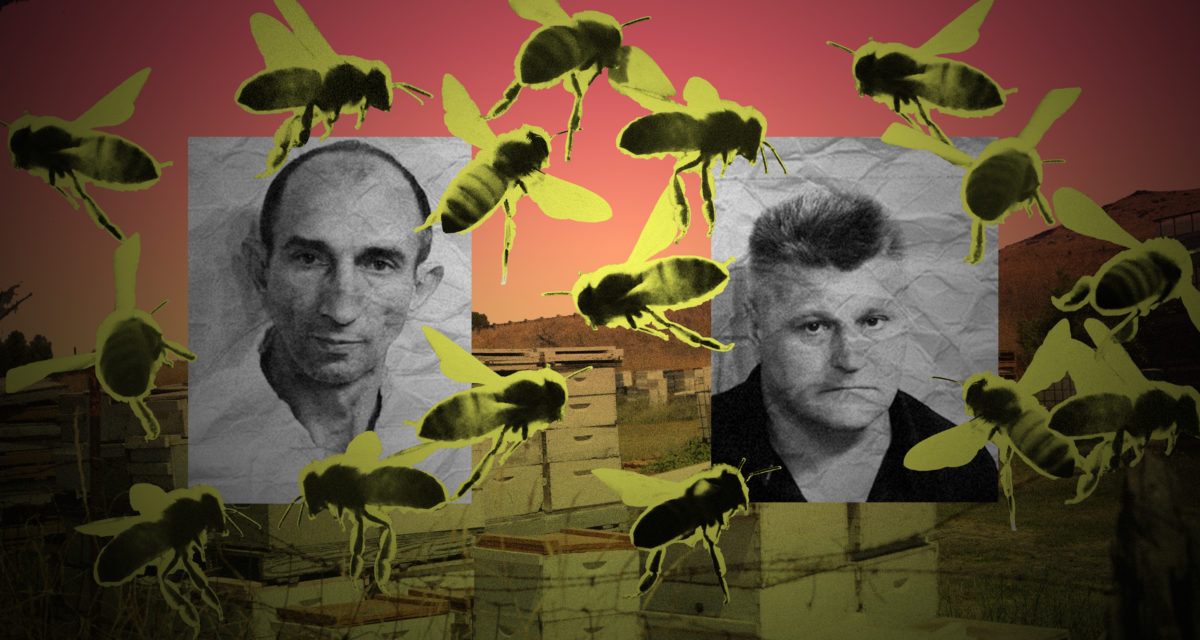
California’s Almond Harvest Has Created a Golden Opportunity for Bee Thieves
Hives have never been more valuable.
This story was originally published by Reveal and appears here as part of the Climate Desk collaboration.
The crime scene was a mess of boxes, some half-assembled, others scattered across patches of dried grass and partially gouged to raw wood. The victims scrambled about looking for food and water. There were thousands of them. Maybe millions.
Detective Isaac Torres watched the action from the air-conditioned safety of his unmarked truck. In five years investigating rural farm crime, he’s seen a lot: stolen construction equipment and copper wire, hay thieves, cargo heists.
“You name it, we pretty much cover it, if there’s any type of ag nexus to it,” he said.
But what he was looking at now, in this scrubby field 10 miles southeast of downtown Fresno, California, was something else entirely.
“What we had here was a chop shop, but of beehives,” Torres said. “You had some beehives that were alive, and you had some hives that were dead. You had hives that were basically cut up: Tops of boxes were over here on this side of the field, and the other parts of the box are on the other side.”

As a member of the Agricultural Crimes Task Force for the Fresno County Sheriff’s Office, Torres knew that bees have become big business in California—that they are an essential ingredient in the state’s yearly almond harvest; that three-quarters of America’s domesticated supply is trucked into the state each winter and rented out. He knew how valuable the insects have become—to farmers, yes, but especially to thieves, who in recent years have grown bolder, greedier.
On this hot afternoon in April 2017, he also knew to keep his distance. It’s one thing to inspect stolen property; it’s quite another to get mobbed by it and pumped with venom. And this property was zipping chaotically through the cloudless sky, unhealthy and irate. Even cracking a window surely would have spelled disaster, he said—“like trying to put toothpaste back in the tube.”
Torres had been summoned here by Alexa Pavlov, a Missouri-based beekeeper who sat in her own rental car nearby. Two days earlier, she’d learned that a $50,000 cluster of her hives, recently stolen from a neighboring county, might well be sitting in this very field. She’d dropped everything, boarded a red-eye to California and driven straight from the airport into the state’s agricultural epicenter. She couldn’t afford not to.
Groggy and impatient, she stepped out of her car and set off toward the boxes. Torres watched in horror as she marched into a haze of bees, poking through hives and snapping photos. Before long, she returned with shots of her initials etched onto the bottom of a pallet—proof that her property was here.
Nearby, Pavel Tveretinov, a thin 51-year-old Sacramento man, was moving through the field, tending to hives in a protective suit. Pavlov confronted him, she later said, and he denied stealing anything. Before long, deputies from Madera County, where Pavlov’s bees had first gone missing, arrived on the scene. They doubted Tveretinov’s account and put him in jail that evening.
Word of the discovery, and the arrest, spread quickly through America’s small commercial beekeeping community. In the days that followed, Torres’s department received dozens of calls from across the country. Beekeepers wanted to know whether their hives were among those recovered—at this chop shop or at three others authorities found later, connected to Tveretinov and alleged accomplice Vitaliy Yeroshenko.
“Some of them were like, ‘Well, I had beehives that were stolen three years ago,’” Torres said. “Some five years ago.”
By the time Torres and his team got a handle on the totals, they were dealing with 2,500 hives, worth nearly one million dollars, some stolen from orchards hundreds of miles apart. This was much more than an impulsive theft: It was the largest bee heist any of them had ever heard of. Perhaps the largest in U.S. history.

Leave any city in the Central Valley, heading in essentially any direction, and it won’t be long before you hit the almond orchards. They stretch for miles, in neat rows of alien emerald, butting up against dust-beaten truck stops and boxy McMansions. Some host campaign signs for local politicians; others are cross-hatched by roads whose names are simply letters because no one, evidently, had the time to get fancy.
California’s total almond acreage has nearly tripled in the past 20 years, a spike due in large part to foreign demand. At the moment, there are about one million acres of nut-bearing trees in the state, with an additional 330,000 on track to start producing over the next four years. The trees produce well over two billion pounds of nuts per year, and they’re sucking down the valley’s aquifers at a rapid pace.
Such growth has driven a near-manic demand for honeybees, which are crucial for what has become the largest managed annual pollination event in the world.
Hives have never been more valuable. Every almond farmer needs two healthy colonies per acre of trees at an average seasonal rental price of around $185 per colony, and that number is expected to climb in the coming years. When everything goes right for a beekeeper, especially one with thousands of well-maintained hives, winter in California presents an enormous money-making opportunity.

The rental process works like this: Toward the end of January, millions of hives arrive in California from all over the country. The bees live in boxes, which themselves are stored in stacks and covered with finely woven mesh during transit. By the time they reach a staging area—sometimes a large field not far from where the bees will be put to work—they’ve been bumping around on the back of a flatbed for several days. Almond farmers inspect the hives, which are then moved into orchards by beekeepers and “brokers” who help manage the transaction.
There are inherent perils to hanging a business on the collective health of a fragile and disease-prone insect. Bee populations are notoriously unstable, and the animals’ health and population strength are constantly under threat. Even though the total population of domesticated honeybees has increased around 45 percent worldwide since 1961, the proportion of agricultural crops that depend on pollinators is growing at a rate closer to 300 percent, stoking fears in certain scientific circles of a global pollination crisis. Wild bee populations, too, are facing steep declines.
In California, “we’ve had a sufficient supply” of bees thus far for each almond harvest, said Bob Curtis, the Almond Board of California’s associate director of agricultural affairs. “But every year before the bloom, I am personally concerned. Are we walking a fine line here?”
Beekeepers certainly do. On top of larger environmental concerns, the price of maintaining healthy hives can fluctuate wildly, depending on a host of risks, including pesticide exposure, mites, drought, and colony collapse disorder, a mysterious epidemic in which worker bees suddenly abandon their queen, leaving her to die. Dealing with these issues means incurring unexpected, sometimes astronomical costs. During a drought year, when pollen and nectar are in short supply and must be artificially supplemented, it’s possible to spend $200,000 more than anticipated just to keep the bees alive.

“It’s death by a thousand cuts,” said David Bradshaw, a lifelong beekeeper in the San Joaquin Valley. His base of operations, in a lot behind his home in Visalia, is typical for a commercial apiarist: There’s a small fleet of trucks, tankers of man-made sugar mixtures, and dozens of bee boxes stacked under a patch of sparse shade. Hundreds more, he said, are deposited across the state.
“My wife comes from a background of a CFO of a school district,” he said. “They have budgets, and they have things that tell where you’re supposed to end up at the end of the year. She asked me, ‘So what’s your budget?’ Like I have one!”
Many of the beekeepers who bring hives to California from Louisiana, Florida, and elsewhere live nomadic lives. Their entire year is spent preparing hundreds of thousands of delicate insects for a nonstop, cross-country trek, followed by a monthlong bonanza of hard labor in an unfamiliar environment. The trips are difficult on the animals, which are especially susceptible to heat and sickness during transit. An unexpected fire or truck tipover (of which there are surprisingly many) can wipe out millions of them—along with a beekeeper’s entire livelihood.
The one certainty: “You can’t just leave your bees in one place anymore,” said Denise Qualls, a bee broker who connects apiarists and almond farmers. “The bees come to California for the almonds. They stay for a month or two, then they go to Oregon and Washington for apples. They’ll go to Texas for whatever honey flow is there. They’ll go to Louisiana. They’ll go up to Maine. They’ll end up in North or South Dakota.”
The whole process can be exhausting, repetitive, and expensive.
“You get out of almond pollination, then your major goal for the next 11 and a half months is making sure your bees are healthy enough to go into almond pollination again,” said Charley Nye, manager of U.C. Davis’ Harry H. Laidlaw Jr. Honey Bee Research Facility.
The almond harvest, he added, is “a weird driver” of market forces—one “that’s kind of pushing everything in one direction. We’re trying to bend the honeybees around it.”

The economics of stealing beehives is a lot like the economics of stealing any high-value item, such as jewelry or electronics, with the main difference being accessibility. During the almond harvest, hives in California’s orchards rarely are protected by alarms or even fences, and equipping individual boxes with GPS trackers is prohibitively expensive for most. To ensure the best pollination results, beekeepers usually place their boxes just off remote roads, hidden by trees, miles from so much as a streetlight. It’s perfectly common for thousands of dollars’ worth of bees to sit largely unattended for weeks at a time.
The theft itself requires a peculiar combination of nihilism and finicky care. You must be the sort of person who’s willing to disregard a generations-old edict, invoked ceaselessly by lifelong apiarists, that “you don’t steal another man’s bees.” Yet pulling it off perfectly is also a dainty affair. You work quietly, gently, usually at night. You cannot jostle the hives too much, lest you damage the queen, which can cause the bees to lose interest in pollination. And it’s not enough to place the bees in a warehouse somewhere; they need access to a water source and all the typical treatments and feedings (sugar water, pollen patties) a doting keeper would provide.
Their value, after all, lies in their apparent health at the point of delivery to a farmer. Sick bees don’t sell.
It’s for these reasons that many of California’s most lurid and notorious bee heists have been perpetrated by apiarists gone rogue. In 1977, the beekeeper David Allred was sentenced to a minimum of three years in prison for lifting $10,000 worth of hives from another keeper in Tracy, California—and using stolen trucks to move them. A deputy district attorney told the presiding judge that Allred “wanted to be known as the Jesse James of the beehive industry,” according to The Press-Enterprise in Riverside.
It wasn’t Allred’s first brush with the law. The year before, he’d gone to jail for helping another beekeeper, David Graves, poison 15 million bees that belonged to a man who’d recently married Graves’s ex-wife and subsequently kicked Graves’s ass after an escalating series of vandalisms. And a few years ago, Allred was sued for taking $30,000 worth of bees that weren’t his—and tricking local sheriff’s deputies into helping him pull off the score.

In 2012, the owner of Tauzer Apiaries, not far from Sacramento, noticed that about 80 of his hives were missing. He pulled together a search party, which soon found parts of the bee boxes scattered along a nearby highway; they also found a bucket of green paint. The clues eventually led them to the beekeeper Viktor Zhdamirov, who had mixed the stolen bees in with his own—and painted the boxes the same shade of green that had stained the bucket. He got three years in prison and was forced to pay more than $60,000.
And in early 2014, the Bakersfield-area beekeeper Joe Romance hatched a plan to recover nearly 200 hives that recently had been taken from him. Shortly after his property went missing, an unknown beekeeper arrived in town and began conducting business from Starbucks, a location most locals agreed was profoundly weird and suspicious. Romance asked a friend to pose as an almond farmer interested in leasing bees. Sure enough, his property was found sitting in a chop shop surrounded by razor wire.
This sort of theft has been an intermittent phenomenon across California for years. But recently, the numbers have started to climb. More than 2,700 hives were reported stolen from 2016 to 2017, according to an analysis of police records by Rowdy Jay Freeman, a sheriff’s deputy in Butte County and a beekeeper himself. In the three years before that, the average number of annual reported thefts was closer to 100.

“It’s very lucrative business,” said Isaac Torres, the agriculture detective. Yet at the same time, “it’s not just some guys who are breaking into cars, or deciding, ‘I’m going to go steal some bees!’ ”
The thieves were cautious and methodical. They likely skipped from orchard to orchard, stacking boxes quickly onto a truck at night. They were familiar with the ins and outs of transporting bees—and keeping them healthy enough to rent out later.
Little else is known about how the thefts were conducted. The 2017 Fresno County case is still working its way through the court system, and officials are limited in how much they can discuss it. Alexa Pavlov, the beekeeper who confronted Pavel Tveretinov last year, has stopped answering calls.
But some have expressed doubt that Tveretinov and alleged accomplice Vitaliy Yeroshenko will face penalties commensurate to the volume of bees stolen. Without an abundance of eyewitness accounts or physical evidence, the two are being charged with 10 counts of receiving stolen property exceeding $950. In July, the Fresno County District Attorney’s Office added two grand theft charges.
“They always say in law enforcement, ‘What you know is one thing; what you can prove is another,’” said Andres Solis, a Fresno County sheriff’s deputy who has worked on the case. The evening he first saw the field where Tveretinov was arrested, he’d been on the job roughly a month. Today, he has a deep understanding of what bees, and bee theft, mean to California.
“It’s not just the property itself that they’re out,” Solis said. “It’s also the man hours spent bringing these bees up and making the hive healthy. … You get your bees back and they’re nothing like they were before.”

One morning before leaving Fresno, I drove an hour east, to one of the sites where authorities discovered hundreds of boxes of stolen hives. I wanted to see firsthand what an illicit bee operation looks like and, a year after the arrest of Tveretinov and Yeroshenko, what had become of the insects they’re accused of stealing.
The field was so remote that it didn’t have a proper address. To point me there, Torres dropped a pin on Google Maps, then recited from memory a short soliloquy of landmarks. I left early in the morning, hoping to evade the heat. But by the time I arrived, it was close to 100 degrees.
The spot was perfect for keeping bees: an overgrown field, about an acre long, nestled between an orchard and a man-made canal. It was close to a main road, but completely hidden if you’re speeding by at 60 mph.
Inside a perimeter of rusty barbed wire, hundreds of bee boxes sat in squat stacks. Just like the ones Torres described, these were painted a variety of colors. I stood near the perimeter, watching as thousands of bees launched from their hives, cutting through the scorching air.
Near the boxes was an abandoned van, a couple of bicycles, a flatbed, and an old Coachmen RV. A year after Tveretinov’s arrest, some beekeepers still had not retrieved their hives. It is, after all, quite costly to ship bees across the country with no guarantee they’ll arrive in the condition you’d delivered them. For some, getting their property back wasn’t worth the gamble.
Up an embankment just yards away, cars roared past on a two-lane highway. A curious driver could easily have pulled over and peered into the field, spotted the makings of an alleged criminal enterprise whose size and peculiarity would be virtually unprecedented in California. One deputy said he’d sped past this field dozens of times on his way to headquarters. He’d never stopped.
“There’s bees there,” he said. “But you don’t think nothing of it. It’s bees. It’s pretty common to see beehives.”
I got as close as any bee novice probably should. Watched the stolen property zip through the air, folding in and out of kaleidoscopic clouds. Then I headed back to my rental car and began the long drive home, through miles and miles of almond trees.
This story was published in collaboration with The Journal of Alta California. Read more at altaonline.com.

Gastro Obscura covers the world’s most wondrous food and drink.
Sign up for our email, delivered twice a week.































Follow us on Twitter to get the latest on the world's hidden wonders.
Like us on Facebook to get the latest on the world's hidden wonders.
Follow us on Twitter Like us on Facebook